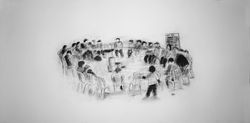 |  |  |
|---|---|---|
 |  |  |
 |  |  |
 |  |  |
 |  |
CATALINA
STAR /
ESTRELLA CATALINA
The work of Rudolph Castro travels the limit where the drawing seems to penetrate in the territory of the photograph. Not because of a hyperrealism, but because of the artist's profound ability to understand the most sublime spring of the photographic act: that which unites spontaneity, whip in the eye, and a unique (particular) way of capturing intangible atmospheres. Incidentally Flaneur, a walker from a Buenos Aires night, Castro portrays corners that will be milestones in his trip, and that his monochrome drawings return dear. These drawings become in Steles, bursts of memory embodied in an immobile time, as frayed towards an outside in traces of graphite. It is that out of the field of the tacit that unites Buenos Aires with its native Lima: For a moment, they will become the same city. At other times, anti-postcards of a contemporary South America: stripped, small and extraordinary.
Gabriel Valansi
May 2016
________________
La obra de Rudolph Castro transita el límite donde el dibujo parece adentrarse en el territorio de la fotografía. No por pretender un hiperrealismo, sino por la profunda capacidad de este Artista de entender el resorte más sublime del acto fotográfico: ese que une espontaneidad, látigo en la mirada, y una única (particular) manera de capturar atmósferas intangibles. Flaneur incidental, caminante de una Buenos Aires anochecida, Castro retrata esquinas que serán hitos en su viaje, y que sus dibujos monocromos vuelven entrañables. Estos dibujos devienen en estelas, ráfagas de memoria plasmadas en un tiempo inmóvil, como deshilachadas hacia un afuera en rastros de grafito. Es ese fuera de campo de lo tácito que une Buenos Aires con su Lima natal: Por un momento serán la misma ciudad. En otros, anti-postales de una Sudamérica contemporánea: despojadas, pequeñas y extraordinarias
Gabriel Valansi
Mayo 2016